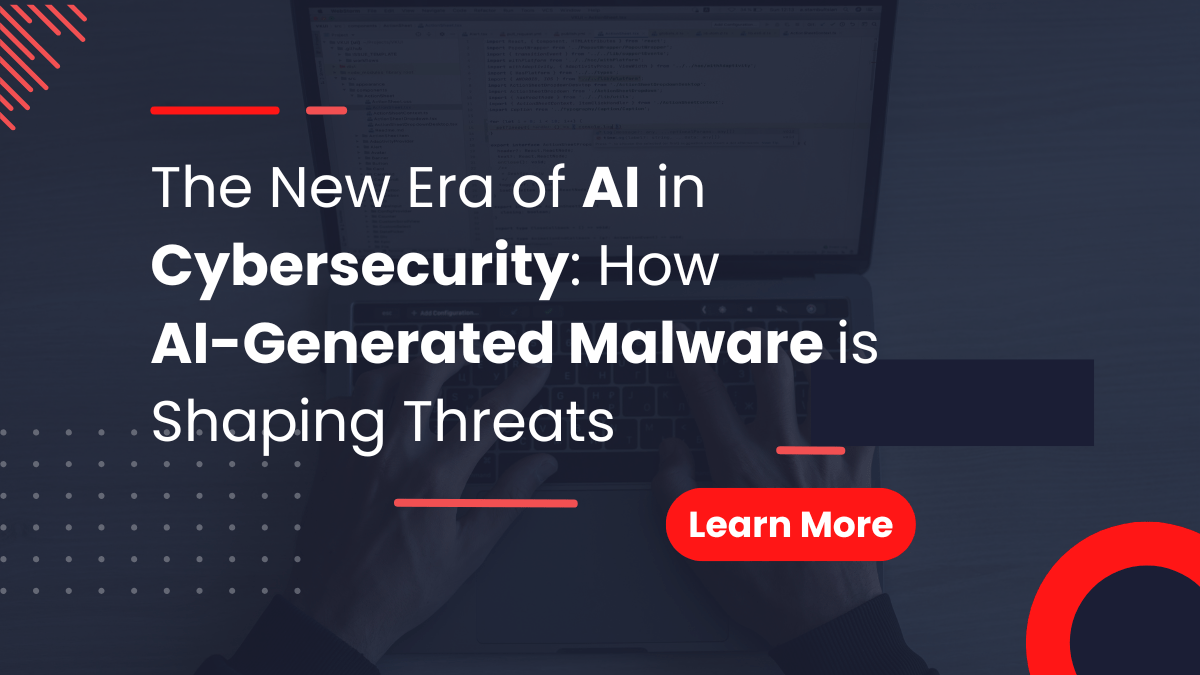The rapid advancement of artificial intelligence (AI) has profoundly impacted numerous industries, and cybersecurity is no exception. While AI offers incredible potential for enhancing security, it has also become a powerful weapon in the hands of cybercriminals.
This blog post explores the evolving landscape of AI-generated malware, its implications for cybersecurity, and the crucial role of AI in combating this new threat.
We will examine how AI is changing the nature of malware attacks, the development of AI malware detection tools, and the importance of proactive strategies in the face of this ever-evolving threat landscape.
The Dangers of AI-Built Malware and AI in Cybersecurity
The rise of AI in cybercrime has ushered in a new era of sophisticated malware, posing unprecedented threats to individuals, organizations, and governments. Unlike traditional malware with fixed behaviors, AI-powered malware dynamically adapts, learns, and optimizes its attacks in real time.
This adaptability makes it incredibly difficult to detect and mitigate using traditional antivirus measures. AI malware can alter its behavior or appearance based on the security environment it encounters, effectively evading detection.
One of the most concerning aspects of AI-driven malware is its capacity for precision targeting. By leveraging vast datasets obtained from previous breaches, AI malware can create highly convincing phishing emails, pinpoint system vulnerabilities specific to a target, and even simulate human-like behavior to bypass anomaly detection systems. This hyper-specific targeting significantly increases the malware’s efficacy, leaving victims with minimal time to react.
Furthermore, AI-powered malware possesses the ability to autonomously improve itself. By analyzing its successes and failures, it refines its attack strategies without human intervention.
A failed intrusion attempt becomes a learning opportunity, allowing the malware to adapt and exploit a different vulnerability. This self-learning capability transforms malware from a static tool into a dynamic and highly unpredictable threat.
The fusion of AI and malware represents a seismic shift in cybersecurity, demanding a robust and proactive response.
Hyper-Specific Targeting: A New Level of Sophistication in Malware Attacks
AI-powered malware excels at creating custom attacks by leveraging data analysis and adaptive algorithms to exploit the unique vulnerabilities of its targets.
Using vast amounts of stolen or publicly available data, it analyzes a target’s digital footprint to craft highly personalized phishing emails, social engineering schemes, or exploit payloads. This precision allows the malware to convincingly mimic trusted sources, significantly increasing the likelihood of a successful attack.
Once inside a system, AI malware continues to adapt. It analyzes the environment in real time, identifying security protocols, unpatched vulnerabilities, and sensitive files. It then tailors its behavior to avoid detection and maximize damage.
For instance, it might deploy ransomware designed to lock only the most critical files or exfiltrate data while disguising itself as legitimate network traffic.
This dynamic adjustment makes AI-driven attacks far more effective and harder to counter than traditional, one-size-fits-all malware. The ability to personalize attacks and adapt to the specific environment makes AI-generated malware a particularly dangerous threat.
Adaptability and Stealth: The Elusive Nature of AI Malware
Malware built with AI excels at stealth by mimicking legitimate software and constantly adapting to its environment. It uses machine learning algorithms to analyze the systems it infiltrates, learning how to blend in and avoid detection by antivirus programs or intrusion detection systems.
It can alter its code on the fly to bypass signature-based defenses, employing polymorphic techniques that generate new variants each time it executes. This “shape-shifting” ability renders many traditional security tools obsolete.
Beyond evasion, AI malware’s adaptability allows it to tailor its behavior to its surroundings. If it detects a heavily monitored network, it may lay dormant, waiting for a less stringent security moment. Conversely, in less-secure environments, it can operate more aggressively.
By continuously analyzing and responding to changes in its environment, AI malware becomes a moving target—nearly invisible to static defenses and a nightmare for cybersecurity teams to contain. This adaptability highlights the need for dynamic and AI-powered defense mechanisms.
Speed of Programming: The Accelerated Threat Landscape
Another major concern with AI-powered malware is the speed at which threat actors can create custom malware. AI automates complex development processes that once required significant time and expertise.
Machine learning algorithms analyze large datasets of vulnerabilities, system configurations, and security protocols, allowing AI to identify exploitable weaknesses at unprecedented speeds.
This data-driven approach enables attackers to quickly tailor malware to target specific systems, industries, or individuals, ensuring a higher success rate than traditional attacks.
AI also simplifies the coding process, enabling cybercriminals to generate malicious code with minimal effort. Using AI tools to write, test, and refine malware, threat actors can rapidly produce sophisticated variants designed to bypass modern security measures.
Generative AI models can create polymorphic malware capable of altering its code with each execution, ensuring it remains undetected by traditional antivirus tools.
This automation reduces development time and lowers the technical barrier, empowering even less-skilled attackers to deploy advanced threats. The speed at which AI can generate new malware variants is a significant challenge for cybersecurity professionals.
Fighting Fire with Fire: AI-Powered Cybersecurity
The rise of AI-powered malware has spurred the development of AI-driven cybersecurity solutions, creating a high-stakes arms race in the digital realm.
As attackers use AI to craft dynamic malware, cybersecurity teams deploy their own AI tools to detect, analyze, and counter these threats in real time. This reflects the dual-edged nature of AI technology—a weapon for attackers and a shield for defenders.
AI-powered cybersecurity solutions excel at identifying patterns and anomalies that might elude traditional defenses. Machine learning models analyze massive volumes of network data to spot subtle deviations indicative of an attack, such as irregular login behavior or unusual file access patterns.
This proactive approach allows defenders to detect and neutralize AI malware before significant damage occurs. AI can also automate responses, such as isolating compromised systems or deploying patches, speeding up reaction times.
However, as defenses improve, so does the malware. AI malware can study the behavior of AI defenses, learning to mimic legitimate activity or find new ways to bypass detection systems.
This feedback loop creates an ongoing escalation where both sides must constantly innovate. Organizations need to invest in advanced AI cybersecurity tools and cultivate a multi-layered strategy to mitigate risks. The development of AI malware detection tools is crucial in this ongoing battle.
The Role of Cybersecurity Training in the Age of AI
In the age of AI-driven threats, cybersecurity awareness and education are vital frontline defenses. AI-powered tools can craft deceptive phishing emails, mimic trusted contacts, and exploit human psychology with precision.
Educating individuals and organizations about these tactics helps build a critical layer of defense. When people recognize red flags, they can thwart even the most advanced AI-crafted social engineering attempts.
Cybersecurity education must also evolve to address the dynamic nature of AI threats. It’s not enough to teach basic practices like strong passwords or software updates. Individuals need to understand emerging risks, such as AI-generated deepfake scams or polymorphic malware, and how to counter them.
Empowering users with knowledge and fostering a culture of security ensures that technology alone isn’t relied upon for protection. In an age where AI enables both attackers and defenders, educated employees remain a critical and irreplaceable line of defense.
AI cybersecurity training is essential for building a strong human element in the defense against AI-generated malware.
Conclusion
The rapid integration of AI into both cybercrime and cybersecurity marks a pivotal shift in the digital landscape. Dark AI has given cybercriminals tools to launch more sophisticated, personalized, and adaptive attacks, making traditional defenses increasingly inadequate.
However, this same technology is driving groundbreaking advancements in cybersecurity, empowering defenders with tools to analyze, predict, and counter these new threats in real time.
This tug-of-war between offense and defense highlights the critical need for a proactive approach to cybersecurity. It’s not just about adopting the latest technologies but also about fostering a culture of vigilance, education, and preparedness.
By understanding the evolving tactics of AI-powered threats and leveraging equally innovative solutions, organizations and individuals can adapt to this new reality with resilience and confidence.
The AI revolution may have reshaped the playing field, but with the right strategies, the fight for secure systems and data is far from lost. The continued development and implementation of AI in cybersecurity are crucial for staying ahead of the evolving threat landscape.
FAQs about AI Cybersecurity
- Q: What is AI-generated malware? A: AI-generated malware utilizes artificial intelligence to create sophisticated, adaptive, and highly targeted attacks that can evade traditional security measures.
- Q: How does AI make malware more dangerous? A: AI enables malware to learn, adapt, and personalize attacks, making it more difficult to detect and mitigate. It also accelerates the development of new malware variants.
- Q: What role does AI play in cybersecurity defense? A: AI is crucial for developing advanced detection systems, analyzing vast amounts of data to identify threats, and automating responses to security incidents.
- Q: What is the importance of AI cybersecurity training? A: AI cybersecurity training is essential to educate individuals and organizations about the evolving threats posed by AI-generated malware and to build a human-centric layer of defense.
- Q: How can organizations protect themselves against AI-powered malware attacks? A: Organizations should invest in advanced AI-powered security solutions, implement a multi-layered security strategy, and prioritize cybersecurity awareness training for their employees. The use of AI malware detection tools is also crucial.









